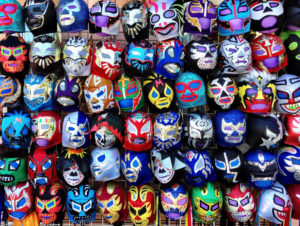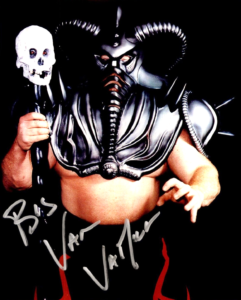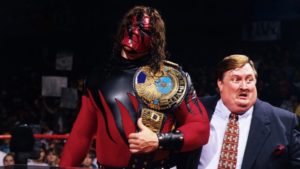
Professional wrestlers as living comic book superheroes/supervillains are always a good subject. With that in mind, let’s return to that idea by saluting some of the great masked grapplers who have graced the ring over the years!

I’ve always had a thing about masks in general, so wrestlers who competed under the hood were intriguing to me. Nobody knew of his identity or background. Not even the announcers knew and they were supposed to know everything! How could a wrestler map out a game plan against these guys? Did they hide any foreign objects in their masks? Who would know if they were registering pain with their faces concealed? Which wrestler would succeed in tearing the mask off the guy’s head? Each of these questions and more were in the back of fans’ minds when masked marvels like the Destroyer, Mr. Wrestling I and II, the Assassins, and the Masked Superstar hit the ring.
Masks also came in handy on a temporary basis, such as the unfair exile of a fan favorite due to contractual stipulations. Take the time that the Junkyard Dog and Mr. Olympia—another noteworthy masked wrestler—defended Mid-South’s tag team titles against Ted DiBiase and Matt Borne. Whoever lost the match would have to leave the territory for 90 days. Things went awry when Hacksaw Jim Duggan interfered on DiBiase and Borne’s behalf to lay the JYD out for the pinfall. Despite the grave injustice, the Dog had no choice but to take a 90-day vacation. Stagger Lee soon emerged on the scene; a masked grappler who bore more than a passing resemblance to the Junkyard Dog. Everyone seemed to know the score, but all were unsuccessful in their attempts to expose the masked man. Junkyard Dog returned to Mid-South after 90 days had elapsed. Stagger Lee coincidentally vanished into thin air around the same time, but not before giving DiBiase, Borne, and Duggan a couple good beatings.
Masked wrestlers were on a different level elsewhere in the wrestling world, but you had to be quite the sophisticated fan in the pre-Internet age to know that. I personally knew next to nothing about Mexico’s longtime lucha libre tradition until masked marvels like Rey Mysterio Jr., Psicosis, and Juventud Guerrera began tearing up WCW’s cruiserweight division in the mid ‘90s. Although I had seen the legendary Mil Mascaras on TV years before at the tenth Clash of Champions, this was the first time I was able to see the incredibly fast-paced and acrobatic Mexican style as practiced by wrestlers who actually took pride in their craft. Some had referred to Mexican wrestling in a derisive fashion, but I think that weekly viewings of Rey Mysterio versus anyone in 1995 and ’96 would change any doubter’s mind! Mysterio’s classic mask vs. cruiserweight championship match against Eddy Guerrero at Halloween Havoc ’96 is not only one of the decade’s best, but the stipulation itself embodies the lucha tradition. I cannot begin to describe the importance of one’s mask in lucha libre; you might compare the loss to a real-life unmasking of your favorite comic book hero. Unmasked wrestlers are often unable to recover from the defeat. Mysterio wasn’t just fighting to win a title at Halloween Havoc—he was fighting to keep his honor and respect, his life’s blood, his very identity!
Those who are able to retire with their mask intact are among lucha’s greatest. El Santo is THE undisputable all-time legend in lucha libre. He popularized professional wrestling in the 1940s and ‘50s with his war against the Black Shadow and Blue Demon, who teamed together as Los Hermanos Shadow. Santo eventually defeated Black Shadow in a mask vs. mask match before embarking on a career-defining feud with Blue Demon. Santo took his role seriously, going to great lengths to conceal his identity. When traveling to matches, he would take different flights from the other luchadores so they would not see his face when he had to unmask to get through customs! Santo finally showed his face during an appearance on the Mexican television program Contrapunto in January of 1984. He passed away a week later. El Santo also appeared in over fifty movies, in which he was the superhero saving the world from such evils as Martians and vampire women. Santo’s movies are relatively easy to find on DVD, so give them a look! They will take you back to the days of B-grade science-fiction movies and Republic Pictures serials from the 1940s!

New Japan Pro Wrestling actually took the wrestler-as-comic-book-hero/villain concept to heart more than once when they brought several manga and anime characters to life. Tiger Mask was the first, a wrestling character from a popular series in both mediums. Critics initially scoffed at the idea, but quickly changed their tone when Satoru Sayama debuted under the Tiger Mask against the vicious gaijin Dynamite Kid! Although their series of matches look normal by today’s standards, their classic feud often stole the show in 1983. Antonio Inoki vs. Abdullah the Butcher may have been the main event, but everyone left the arena talking about Tiger Mask and Dynamite Kid’s hate-filled war over the junior heavyweight title! Tiger Mask far exceeded expectations—there have been five incarnations of the character in all, including one portrayed by the late Mitsuharu Misawa. Black Tiger was Tiger Mask’s animated arch-enemy, so it was inevitable that he would also appear in the ring. Seven different wrestlers have appeared as Black Tiger over the years, including British grappler Mark “Rollerball” Rocco and the late Eddy Guerrero. New Japan scored big once again in the late ‘80s when they brought Go Nagai’s Jushin Liger character from the manga pages and into the squared circle. Liger would put the junior heavyweight division back on the map with a variety of opponents, culminating in the famed Super J Cup tournament in 1994. WCW fans certainly remember his matches with Brian Pillman in the early ‘90s. Jushin Liger still tears it up to this day; American fans have been thrilled to see him appear in TNA, Ring of Honor, and NXT.

Big Van Vader was actually another Go Nagai creation that New Japan imported to the True Sport of Kings, supposedly inspired by a samurai character in Japanese folklore. Vader entered New Japan as part of Takeshi Kitano’s Takeshi Puroresu Gundan group and immediately destroyed the promotion’s top star, the legendary Antonio Inoki. Wrestling fans hadn’t seen Inoki beaten so severely since he was knocked out by Hulk Hogan’s Axe Bomber four years before! Vader became big in Japan overnight, steamrolling the competition with brute gaijin force. He even simultaneously held world championships from three different continents! Who remembers the crazy iron helmet that Vader used to wear to the ring? I thought that helmet was the coolest thing I had ever seen; it shot smoke into the air and looked like something out of a Giger sketchbook! Vader crushing jobbers on WCW Saturday Night was like wrestling’s answer to King Kong stampeding through Manhattan…those were the days…

Many more masked men have made their mark in wrestling history than I can possibly mention here. There continues to be space for them to occupy in today’s landscape—just watch Lucha Underground for a plethora of colorful masks and characters! I do wonder if there is still room for the mask in American wrestling à la the Destroyer or the Masked Superstar—and who on the horizon could feasibly ascend to Kane’s spot as WWE’s Michael Myers after the Big Red Machine delivers his last choke slam? I hope that the braintrust remembers that Bruce Wayne is a boring rich dude, but Batman is badass and today’s wrestling needs more of the creativity that masks can afford!

